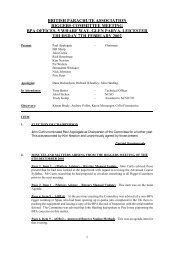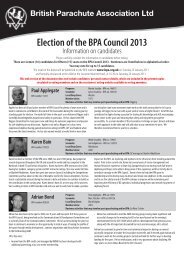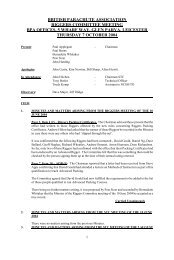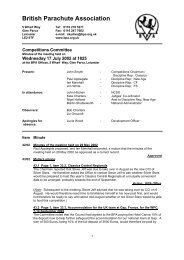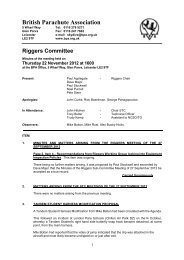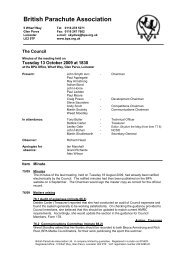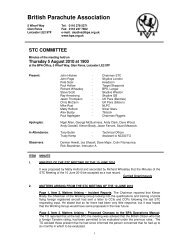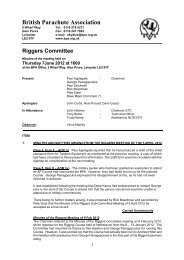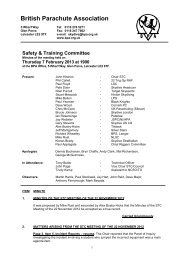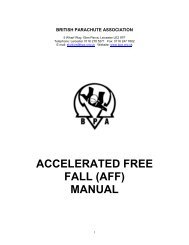Formation Skydiving Progression Manual - British Parachute ...
Formation Skydiving Progression Manual - British Parachute ...
Formation Skydiving Progression Manual - British Parachute ...
Create successful ePaper yourself
Turn your PDF publications into a flip-book with our unique Google optimized e-Paper software.
HEAD: Just think head up. If your torso is in a good position then your head will be too as it is<br />
an extension of the spine.<br />
ARMS AND LEGS: To achieve a balanced neutral flying position you must understand that the<br />
human body is symmetrical in its structure. Pay particular attention to this fact, since the action of<br />
positioning your limbs when flying will create a reaction of either solid powerful moves or a series<br />
of inconsistent compensations. Maintain symmetry with your limbs and you will maintain balance.<br />
The student positioning of the arms can be seen as a bad habit if you want to improve your flying<br />
position. Having a wide arm stance is great for stability - think of a narrow boat with out-riggers.<br />
However, your arms need to be in a position of mobility i.e. in a grip-taking position, as well as<br />
maintaining equal air pressure to that of the legs. Lying on the floor and propping your chin up on<br />
your fists as if watching the TV, then dropping your hands away from your chin, forwards, can<br />
gain a reasonably accurate approximation of the arm position to be aimed for.<br />
Your elbows should be wider and lower than your shoulders as shown in Fig.3. It’s common for<br />
your hands to be too close to the face. Think about creating more surface area as shown in Fig. 4<br />
by extending the arms forwards.<br />
Fig. A.3 Fig. A.4<br />
A common area for improvement for students and even experienced skydivers is in their leg<br />
position. As we know, being wide in a stance provides great stability. However legs being too<br />
wide can cause problems such as de-arching of the hips. Legs are also often too bent which<br />
reduces the overall effective surface area of the body in freefall. One of the reasons these<br />
problems arise is due to the fact that you rely on feeling for leg positioning as you can’t see what<br />
they are actually doing and our sense of feel is often deceiving. Bear in mind that your legs,<br />
especially if in a bootie suit, are much bigger than your arms so they play a vital role in your<br />
position.<br />
Fig A.5<br />
17



